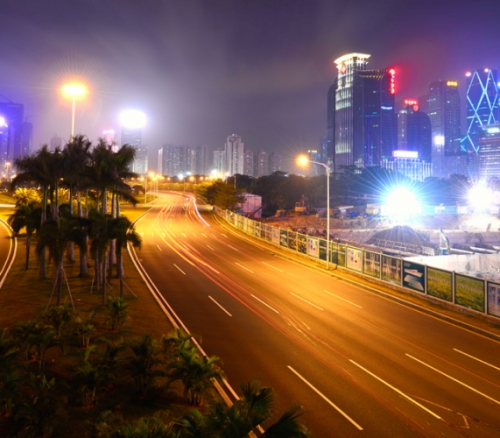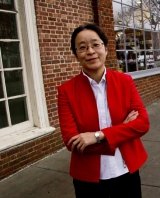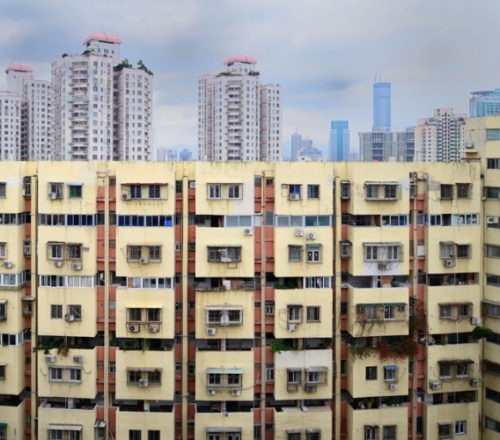Imagine if Myrtle Beach morphed into a megacity double the size of New York City in just three decades. Impossible? Not in China.
In the early 1970s, the sleepy fishing village of Shenzhen was home to 30,000 residents who traveled dirt roads to farm rice and fish the sea. Today, Shenzhen is a metropolis of more than 15 million people who commute to work on superhighways and live in skyscrapers.

Photo by Yan Song
Shenzhen at night. Thirty years ago, the city was a small fishing village.

Click to read photo caption. Photo by Yan Song
That’s just one example of China’s light-speed transformation. The nation scrapped a Soviet-style economy for a market-based and city-based strategy that resulted in 390 million people moving from rural areas into cities during an economic boom unprecedented in human history. Since the 1980s, China has built more skyscrapers, malls, hotels, highways, bridges, tunnels, houses, and apartments than all the other countries combined.
As the economic tsunami was cresting, some leaders turned to Western planners for advice. In 2003, Shenzhen hired a young, U.S.-trained academic named Yan Song as a consultant. Song, who grew up in Shenzhen and was a faculty fellow at UNC, studied how Chinese cities were developing. And she saw trouble. Song decided to invite a group of experts from the American Planning Association to meet with Chinese leaders. The U.S. contingent held nothing back, warning the Chinese to not make the same mistakes that U.S. cities made during the nineteenth and twentieth centuries.
“We told them not to tear out Beijing’s bike lanes,” Song remembers. They told the Chinese that more cars would cause major problems and that different kinds of development projects—transportation, industrial, commercial, residential, and educational—needed to be better integrated. “But they didn’t listen,” Song says. It was cheaper and quicker to ignore such approaches, which would’ve required overhauling the way China’s planning agencies operated.
China stayed the course. Shenzhen turned into a manufacturing supercity, as did dozens of former small cities. And Beijing became one of the most congested and polluted cities in the world.

Wikimedia Commons
The pollution in Beijing was so bad this winter that the air stung the eyes and caused respiratory problems in healthy people.

Click to read photo caption. Wikimedia Commons
This past winter, the level of pollution in the capital city was 25 times higher than what’s considered safe, and 29 other Chinese cities were enshrouded in a gray haze of smog so dense that it stung the eyes.
That’s just the air. “Rivers are open cesspools,” Song says. And some lakes are so polluted that algae blooms have turned the water into a green, toxic sludge that’s imperiling drinking water for millions of people.
These are some of the unintended consequences of China’s urbanization, which shows no sign of slowing. In 1980, according to China’s National Bureau of Statistics, about 20 percent of China’s population lived in cities. In 2007, it was 42 percent. In 2012, it was 51 percent. The bureau projects that by 2020, 60 percent of China’s population will live in cities.
As this transformation took place, Song joined UNC in 2003 as an assistant professor and continued to consult with Chinese planners. In 2009, she started UNC’s Program on Chinese Cities to provide research, training, and education to Chinese planners and leaders who are open to better planning practices. She formed a consortium between UNC and Beijing University to bring Carolina scholars to China, apply for grants, and work on urban planning projects together.
Song also wrote research papers and books, including Smart Growth for China, in which she documents how China’s urban planning process laid the foundation for economic growth but also curious development patterns, including highways and coal plants built in environmentally sensitive areas, a lack of mixed-use development, and inefficient land-use practices such as sprawling educational campuses and cramped residential complexes.
One cause of such problems, according to Song, is China’s planning bureaucracy. Several planning agencies at various levels of government are responsible for developing different parts of cities, and Song found that those plans are often poorly coordinated.
In Beijing, development plans resulted in a sprawling city with wide roads, encouraging more car use. In Shenzhen, a new subway station was put in a wealthy, low-density residential area because that’s where influential planners and rich residents wanted it. “That station should’ve been built in a medium-to-low-income area,” Song says, where a lot of people live and use trains.
Those sorts of local development shenanigans still plague China, as they do many other countries including the United States, even as planners try to back China out of the uber-urbanization corner.
Still, Song sees positive signs in China, partly because China’s communist party is starting to change the way it does business.
When China began modernizing, Song says, local and provincial political leaders knew they could rise through the ranks of China’s lone political party based largely on how well they adhered to mandates from the central government. And the most important mandate was to urbanize as quickly as possible. As a result, provincial leaders gave little forethought to the environment or sustainable planning practices, such as integrated development of highways, subways, residential areas, commercial hubs, industrial zones, and educational centers.

Photo by Mary Lide Parker
Yan Song, associate professor in the Department of City and Regional Planning and Director of the Program on Chinese Cities in the Center for Urban and Regional Studies.

Click to read photo caption. Photo by Mary Lide Parker
“But that’s gradually changing,” Song says. The central government is now issuing new mandates. “One of them is sustainability,” she says. Another is harmony between rural and urban areas, between poor farmers and wealthier city residents.
Those are two reasons why in 2012 a dozen Chinese mayors came to North Carolina to get a firsthand look at better development practices. Led by Song and UNC colleagues, they toured Research Triangle Park, met with corporate and city leaders, and even visited little Hillsborough to get a feel for how a small town can be vibrant and sustainable.
“Although most Chinese cities are still urbanizing fast, leaders know that such dense and sprawling development might not be what people want,” Song says. “In the United States, there’s a good range of densities amenable to people.”
Song knows that large cities in need of redevelopment have their work cut out for them, but there are many smaller towns—the Shenzhens of the future—that can avoid the mistakes of the recent past. And they’re already looking to Song’s program for help. For instance, she’s linked UNC’s Jack Kasarda with Chinese planners who are intrigued by and using his idea of building aerotropolises: cities planned around airports to allow for integrated urban development geared toward efficient global trade.
“There’s now a huge demand in China for best practices,” Song says. “Where to grow and how to grow. There’s a cry for knowledge.”
And that’s good, because there’s a cry for China to turn its current pollution nightmare into a distant memory … as fast as possible.








